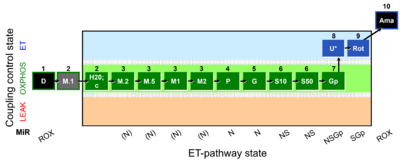| Step
|
State
|
Pathway
|
Q-junction
|
Comment - Events (E) and Marks (M)
|
| 1D
|
ROX
|
|
|
1D
- ADP is added to stimulate consumption of endogenous fuel-substrates.
- Rox is the residual oxygen consumption in the ROX state, due to oxidative side reactions, estimated either after inhibition of CIII (e.g. antimycin A, myxothiazol), CIV (e.g. Cyanide) or in the absence of endogenous fuel-substrates. Rox is subtracted from oxygen flux as a baseline for all respiratory states, to obtain mitochondrial respiration.
|
| 2M.1
|
|
|
|
1D;2M.1
- Low concentration of malate, typically 0.1 mM, does not saturate the N-pathway; but saturates the F-pathway.
- Malate kinetics in the presence of saturating [ADP] allows the evaluation of malate anaplerotic pathways.
|
| 2H2O
|
|
|
|
1D;2M.1;2H2O
- Titration of carrier (H2O) as a control, to be compared with protocols with titration of acylcarnitines to assess fatty acid oxidation-linked respiration.
|
| 3c
|
|
|
|
1D;2M.1;2H2O;2c
- OXPHOS capacity P (with saturating [ADP]), active OXPHOS state.
- Addition of cytochrome c yields a test for integrity of the mtOM (cytochrome c control efficiency). Stimulation by added cytochrome c would indicate an injury of the mtOM and limitation of respiration in the preceding state without added c due to loss of cytochrome c. Typically, cytochrome c is added immediately after the earliest ADP-activation step (OXPHOS capacity P with saturating [ADP]).
|
| 3M.2
|
|
|
|
1D;2M.1;2H2O;2c;3M.2
- Malate kinetics in the presence of saturating [ADP] allows the evaluation of malate anaplerotic pathways.
- OXPHOS capacity P (with saturating [ADP]), active OXPHOS state.
|
| 3M.5
|
|
|
|
1D;2M.1;2H2O;2c;3M.2;3M.5
- Malate kinetics in the presence of saturating [ADP] allows the evaluation of malate anaplerotic pathways.
- OXPHOS capacity P (with saturating [ADP]), active OXPHOS state.
|
| 3M1
|
|
|
|
1D;2M.1;2H2O;2c;3M.2;3M.5;3M1
- Malate kinetics in the presence of saturating [ADP] allows the evaluation of malate anaplerotic pathways.
- OXPHOS capacity P (with saturating [ADP]), active OXPHOS state.
|
| 3M2
|
|
|
|
1D;2M.1;2H2O;2c;3M.2;3M.5;3M1;3M2
- Malate kinetics in the presence of saturating [ADP] allows the evaluation of malate anaplerotic pathways.
- High concentration of malate, typically 2 mM, saturates the N-pathway.
- OXPHOS capacity P (with saturating [ADP]), active OXPHOS state.
|
| 4P
|
PMP
|
N
|
CI
|
1D;2M.1;2H2O;2c;3M.2;3M.5;3M1;3M2;4P
|
| 5G
|
PGMP
|
N
|
CI
|
1D;2M.1;2H2O;2c;3M.2;3M.5;3M1;3M2;4P;5G
|
| 6S10
|
PGMSP
|
NS
|
CI&II
|
1D;2M.1;2H2O;2c;3M.2;3M.5;3M1;3M2;4P;5G;6S10
- Respiratory stimulation by simultaneous action of type N substrates & succinate, with convergent electron flow in the NS-pathway for reconstitution of TCA cycle function.
- OXPHOS capacity P (with saturating [ADP]), active OXPHOS state.
|
| 6S50
|
PGMSP
|
NS
|
CI&II
|
1D;2M.1;2H2O;2c;3M.2;3M.5;3M1;3M2;4P;5G;6S10;6S50
- Respiratory stimulation by simultaneous action of type N substrates & succinate, with convergent electron flow in the NS-pathway for reconstitution of TCA cycle function.
- OXPHOS capacity P (with saturating [ADP]), active OXPHOS state.
|
| 7Gp
|
PGMSGpP
|
NSGp
|
CI&II&GpDH
|
1D;2M.1;2H2O;2c;3M.2;3M.5;3M1;3M2;4P;5G;6S10;6S50;7Gp
|
| 8U
|
PGMSGpE
|
NSGp
|
CI&II&GpDH
|
1D;2M.1;2H2O;2c;3M.2;3M.5;3M1;3M2;4P;5G;6S10;6S50;7Gp;8U
|
| 9Rot
|
SGpE
|
SGp
|
CII&GpDH
|
1D;2M.1;2H2O;2c;3M.2;3M.5;3M1;3M2;4P;5G;6S10;6S50;7Gp;8U;9Rot
- Respiratory stimulation by action of succinate and glycerophosphate, Gp, with convergent electron flow in the SGp-pathway (CII&GpDH-linked pathway to the Q-junction).
- Noncoupled electron transfer state, ET state, with ET capacity E.
|
| 10Ama
|
ROX
|
|
|
1D;2M.1;2H2O;2c;3M.2;3M.5;3M1;3M2;4P;5G;6S10;6S50;7Gp;8U;9Rot;10Ama
- Rox is the residual oxygen consumption in the ROX state, due to oxidative side reactions, estimated after addition of antimycin A (inhibitor of CIII). Rox is subtracted from oxygen flux as a baseline for all respiratory states, to obtain mitochondrial respiration (mt).
|

